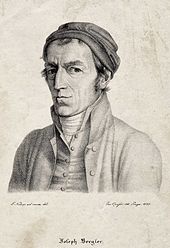Franz Nadorp
Franz Johann Heinrich Nadorp (born June 23, 1794 in Anholt , † September 17, 1876 in Rome ) was a German painter . He belonged to the group of artists of the Nazarenes in Rome.
Life


Franz Nadorp came from a long-established Anholter family of artists, he was the only son of the married couple Johann Theodor Nadorp and Gertrud Anna Stroof. After completing his education at the Anholter City School, he entered the Prague Art Academy at the age of 20 with a scholarship from his sovereign Prince Constantin zu Salm-Salm , where he trained as a history painter with his teacher Joseph Bergler . Nadorp quickly became Joseph Bergler's favorite student. In 1822 he received the gold medal from the Prague Art Academy. When his mentor in Prague died in 1826, Nadorp broke up his tents in Prague and returned to his hometown of Anholt for a few months in 1827.
In the fall of 1827 Nadorp traveled to Rome with his travel companion, Prince Franz-Joseph zu Salm-Salm (1801–1842). At that time, the city of Rome attracted German artists, for example Peter Cornelius , Friedrich Overbeck and Julius Schnorr . Franz Nadorp quickly found his way around the group of so-called German Romans among the group of German artists who were called “Nazarenes”. He was one of the founders of the Ponte Molle Society (1829) and the German Artists' Association (1845). In 1828 and in the following years he complained about the high cost of living in Rome constantly about “dearth and distress” and asked for subsidies. The years 1840–1850 are among his most fertile. Numerous drawings of topographical content have survived.
During this time, Franz Nadorp met King Ludwig I of Bavaria , and both were friends. In 1859 Nadorp received his first state commission from King Friedrich Wilhelm IV of Prussia. Nadorp rarely left Rome in the almost 50 years of his work there. In 1862 he returned to his hometown Anholt for a short time with a detour to (Bonn-) Vilich , his mother's home and burial place. For his baptistery St. Pankratius he created the altar painting The Presentation of Jesus in the Temple and drew this old city church of Anholt, which was about to be demolished and which was rebuilt in 1851 as "Anholter Dom". In 1876 Prince Alfred I zu Salm-Salm granted him an annuity.
Nadorp, who is considered to be an Italian romanticist of German painting, died shortly afterwards in Rome and was buried on the Campo Santo Teutonico next to St. Peter in the Vatican. His entire estate went to the princes of Salm-Salm and can still be viewed today in the Museum Wasserburg Anholt or in the parish church of St. Pankratius Anholt.
literature
- Duco van Krugten: Nadorp, Franz. In: New German Biography (NDB). Volume 18, Duncker & Humblot, Berlin 1997, ISBN 3-428-00199-0 , p. 693 f. ( Digitized version ).
Web links
Individual evidence
- ^ Friedrich Noack : The Germanness in Rome since the end of the Middle Ages. 2 volumes. Deutsche Verlagsanstalt, Stuttgart 1927. Volume 1 (PDF) , p. 499
| personal data | |
|---|---|
| SURNAME | Nadorp, Franz |
| ALTERNATIVE NAMES | Nadorp, Franz Johann Heinrich (full name) |
| BRIEF DESCRIPTION | German painter |
| DATE OF BIRTH | June 23, 1794 |
| PLACE OF BIRTH | Anholt |
| DATE OF DEATH | 17th September 1876 |
| Place of death | Rome |
